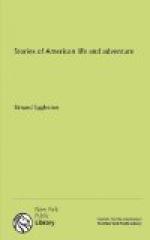The boy slid down the tree in haste. “Monacans on the war path!” he whispered as he reached the ground.
Swiftly and silently the two boys hurried back to their canoe. They wasted no time in admiring it. They gathered their weapons and fishing lines, and got aboard. It was not a question of killing Monacans now, but of saving themselves and their friends. They rowed with all their might from the start.
For hours they kept their new paddles busy. They reached the village after dark, and when they uttered the dreadful word “Monacans,” it ran from one wigwam to another. The women and children shuddered with fear. The warriors smeared their faces with paint, to make themselves uglier than ever, and departed. Soon after the boys had started home, the Monacans had found their camp fire still burning. Thinking they had been discovered, and knowing that a strong party of the Powhatan Indians might come after them, the Monacans had hurried back to their own home more swiftly than they had come.
SOME THINGS ABOUT INDIAN CORN.
When the white people first came to America, they had never seen Indian corn, which did not grow in Europe. The Indians raised it in little patches about their villages. Before planting their corn, they had to clear away the trees that covered the whole country. Their axes were made of stone, and were not sharp enough to cut down a tree. The larger trees they cut down by burning them off at the bottom. They killed the smaller trees by building little fires about them. When the bark all round a tree was burned, the tree died. As dead trees bear no leaves, the sun could shine through their branches on the ground where corn was to be planted.
Having no iron, they had to make their tools as they could. In some places they made a hoe by tying the shoulder blade of a deer to a stick. In other places they used half of the shell of a turtle for a hoe or spade to dig up the ground. This could be done where the ground was soft. In North Carolina the Indians had a little thing like a pickax which was made out of a deer’s horn tied to a stick. An Indian woman would sit down on the ground with one of these little pickaxes in her hand. She would dig up the earth for a little space until it was loose. Then she would make a little hole in the soft earth. In this she would plant four or five grains of corn, putting them about an inch apart. Then she covered these grains with soft earth. In Virginia, where the ground was soft and sandy, the Indians made a kind of spade out of wood.
Sometimes they planted a patch a long way off from their bark house, so that they would not be tempted to eat it while it was green. The Indians were very fond of green corn. They roasted the ears in the ashes. Some of the tribes held a great feast when the first green corn was fit to eat, and some of them worshiped a spirit that they called the “Spirit of the Corn.”




